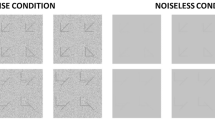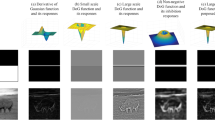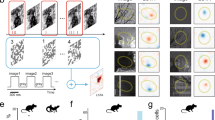Abstract
A generic model of automatic gain control (AGC) is proposed as a general framework for multidimensional automatic contrast sensitivity adjustment in vision, as well as in other sensory modalities. We show that a generic feedback AGC mechanism, incorporating a nonlinear synaptic interaction into the feedback loop of a neural network, can enhance and emphasize important image attributes, such as curvature, size, depth, convexity/concavity and more, similar to its role in the adjustment of photoreceptors and retinal network sensitivity over the extremely high dynamic range of environmental light intensities, while enhancing the contrast. We further propose that visual illusions, well established by psychophysical experiments, are a by-product of the multidimensional AGC. This hypothesis is supported by simulations implementing AGC, which reproduce psychophysical data regarding size contrast effects known as the Ebbinghaus illusion, and depth contrast effects. Processing of curvature by an AGC network illustrates that it is an important mechanism of image structure pre-emphasis, which thereby enhances saliency. It is argued that the generic neural network of AGC constitutes a universal, parsimonious, unified mechanism of neurobiological automatic contrast sensitivity control. This mechanism/model can account for a wide range of physiological and psychophysical phenomena, such as visual illusions and contour completion, in cases of occlusion, by a basic neural network. Likewise, and as important, biologically motivated AGC provides attractive new means for the development of intelligent computer vision systems.






















Similar content being viewed by others
References
Abbott LF, Varela JA, Sen K, Nelson SB (1997) Synaptic depression and cortical gain control. Science 275(5297):221–224
Ben-Yosef G, Ben-Shahar O (2010) Minimum length in the tangent bundle as a model for curve completion. In: Computer vision and pattern recognition, pp 2384–2391
Blakemore C, Campbell FW (1969) On the existence of neurones in the human visual system selectively sensitive to the orientation and size of retinal images. J Phys 203(1):237–260
Brajovic V (2004) Brightness perception, dynamic range and noise: a unifying model for adaptive image sensors. In: Computer vision and pattern recognition. Proceedings of 2004 IEEE computer society conference (2):II-189-II-196
Canny J (1986) A computational approach to edge detection. IEEE Trans Pattern Anal Mach Intell 8(6):679–698
Carey DP, Harvey M, Milner AD (1996) Visuomotor sensitivity for shape and orientation in a patient with visual form agnosia. Neuropsychologia 34(5):329–337
Cavanagh P, Arguin M, Treisman A (1990) Effect of surface medium on visual search for orientation and size features. J Exp Psychol Hum Percept Perform 16(3):479–491
Coltheart M (1971) Visual feature-analyzers and aftereffects of tilt and curvature. Psychol Rev 78(2):114–121
Curran W, Johnston A (1996) Three-dimensional curvature contrast-geometric or brightness illusion? Vis Res 36(22):3641–3653
Du Croz JJ, Rushton WAH (1966) The separation of cone mechanisms in dark adaptation. J Physiol 183(2):481–496
Debevec PE, Malik J (2008) Recovering high dynamic range radiance maps from photographs. In: ACM SIGGRAPH 2008 classes. Los Angeles, California, pp 1–10
Ding J, Sperling G (2006) A gain-control theory of binocular combination. Proc Nat Acad Sci USA 103(4):1141–1146
Do Carmo M (1976) Differential geometry of curves and surfaces. Prentice-Hall, Upper Saddle River
Dobbins A, Zucker SW, Cynader MS (1987) Endstopped neurons in the visual cortex as a substrate for calculating curvature. Nature 329:438–441
Dobelle WH (2000) Artificial vision for the blind by connecting a television camera to the visual cortex. ASAIO J 46(1):3–9
Enns JT, Rensink RA (1990) Influence of scene-based properties on visual search. Science (New York, NY) 247(4943):721–723
Enns JT, Rensink RA (1990) Sensitivity to three-dimensional orientation in visual search. Psychol Sci 1(5):323–326
Faisal AA, Selen LPJ, Wolpert DM (2008) Noise in the nervous system. Nat Rev Neurosci 9(4):292–303
Fantoni C, Gerbino W (2003) Contour interpolation by vector-field combination. J Vis 3(4):281–303
Farzin M, Suomela R (1998) Robust image corner detection through curvature scale space. IEEE Trans Pattern Anal Mach Intell 20(12):1376–1381
Field DJ, Hayes A, Hess RF (1993) Contour integration by the human visual system: evidence for a local ‘association field’. Vis Res 33(2):173–193
Fischler MA, Bolles RC (1986) Perceptual organization and curve partitioning. IEEE Trans Pattern Anal Mach Intell 8(1):100–105
Furman GG (1965) Comparison of models for subtractive and shunting lateral-inhibition in receptor-neuron fields. Kybernetic 2(6):257–274
Gerbino W, Fantoni C (2006) Visual interpolation is not scale invariant. Vis Res 46(19):3142–3159
Gibson JH (1937) Adaptation with negative after-effect. Psychol Rev 44(3):222–244
Ginosar R, Hilsenrath O, Zeevi YY (1992) United States Patent: 5144442–Wide dynamic range camera, U.S. Patent 514444201
Graham M, Rogers BJ (1982) Simultaneous and successive contrast effects in the perception of depth from motion-parallax and stereoscopic information. Perception 11(3):247–262
Gregory RL (2009) Seeing through illusions. Oxford Univ. Press, New York
Griffin LD, Lillholm M, Nielsen M (2004) Natural image profiles are most likely to be step edges. Vis Res 44(4):407–421
Guttman SE, Kellman PJ (2004) Contour interpolation revealed by a dot localization paradigm. Vis Res 44(15):1799–1815
Hancock S, Peirce JW (2008) Selective mechanisms for simple contours revealed by compound adaptation. J Vis 8(7):1–10
Herscovitz M, Yadid-Pecht O (2004) A modified multi scale retinex algorithm with an improved global impressionof brightness for wide dynamic range pictures. Mach Vis Appl 15(4):220–228
Hochstein S, Ahissar M (2002) View from the top: hierarchies and reverse hierarchies in the visual system. Neuron 36(5):791–804
Hoffman DD, Richards WA (1984) Parts of recognition. Cognition 18(1–3):65–96
Hubel DH, Wiesel TN (1968) Receptive fields and functional architecture of monkey striate cortex. J Phys 195(1):215–243
Hubel DH, Wiesel TN (1970) Stereoscopic vision in macaque monkey: cells sensitive to binocular depth in area 18 of the macaque monkey cortex. Nature 225:41–42
Humayun MS et al (2003) Visual perception in a blind subject with a chronic microelectronic retinal prosthesis. Vis Res 43(24):2573–2581
Johnson RP (1990) Contrast based edge detection. Pattern Recognit 23(3–4):311–318
Kaye SB et al (1999) Monocular and binocular depth discrimination thresholds. Optom Vis Sci 76(11):770–782
Kimia B, Frankel I, Popescu AM (2003) Euler spiral for shape completion. Int J Comput Vis 54(1):159–182
Kimmel R, Malladi R, Sochen N (2000) Images as embedded maps and minimal surfaces: movies, color, texture, and volumetric medical images. Int J Comput Vis 39(2):111–129
Kimmel R (2003) Numerical geometry of images: theory, algorithms and applications. Springer, Berlin
Koch C, Mokwa W, Goertz M, Walter P (2008) First results of a study on a completely implanted retinal prosthesis in blind humans. Sensors, 2008 IEEE, IEEE, Lecce, pp 1237–1240. doi:10.1109/ICSENS.2008.4716667
Koenderink JJ, Doorn AJW (1982) The shape of smooth objects and the way contours end. Perception 11(2):129–137
Koenderink JJ, Doorn AJV (1987) Representation of local geometry in the visual system. Biol Cyber 55(6):367–375
Krauskopf J, Mollon JD (1971) The independence of the temporal integration properties of individual chromatic mechanisms in the human eye. J Physiol 219(3):611–623
Kumar T, Glaser DA (1992) Depth discrimination of a line is improved by adding other nearby lines. Vis Res 32(9):1667–1676
Lawlor M, Zucker SW (2013) Third-order edge statistics: contour continuation, curvature, and cortical connections. NIPS, pp 1763–1771
Liu YS, Stevens CF, Sharpee TO (2009) Predictable irregularities in retinal receptive fields. Proc Natl Acad Sci 106(38):16499–16514
Lu ZL, Sperling G (1996) Contrast gain control in first- and second-order motion perception. J Opt Soc Am A 13(12):2305–2318
Mangoubi SS (1979) Noise and thresholds in vision. PhD. Thesis, Technion
Marr D, Hildreth E (1980) Theory of edge detection. Proc R Soc Lond Ser B Biol Sci 207(1167):187–217
Mokhtarian F, Mackworth AK (1992) A theory of multiscale, curvature-based shape representation for planar curves. IEEE Pattern Anal Mach Intell 14(8):789–805
Monroy A et al. (2011) Beyan straight lines—object detection using curvature. ICIP
Ohlson J (1974) Exact dynamics of automatic gain control. IEEE Trans Commun 22(1):72–75
Palanker D: Photovoltaic retinal prosthesis for restoring sight to the blind. http://web.stanford.edu/~palanker/lab/retinalpros.html
Papoulis A (1965) Probability, random variables and stochastic processes. 1st Ed McGraw-Hill Companies
Parent P, Zucker SW (1989) Trace inference, curvature consistency, and curve detection. IEEE Trans Pattern Anal Mach Intell 11(8):823–839
Peli T, Malah D (1982) A study of edge detection algorithms. Comput Gr Image Process 20(1):1–21
Ratliff F (1965) Mach bands: quantitative studies on neural networks in the retina. Holden-Day Inc.
Richards W, Dawson B, Whittington D (1986) Encoding contour shape by curvature extrema. J Opt Soc Am A 3(9):1483–1491
Riggs LA (1973) Curvature as a feature of pattern vision. Science 181(4104):1070–1072
Roberts B, Harris MG, Yates TA (2005) The roles of inducer size and distance in the Ebbinghaus illusion (Titchener circles). Perception 34(7):847–856
Salinas E (2000) Gain modulation: a major computational principle of the central nervous system. Neuron 27(1):15–21
Saucan E, Appelboim E, Zeevi YY (2008) Sampling and reconstruction of surfaces and higher dimensional manifolds. J Math Imaging Vis 30(3):105–123
Schwartz O, Simoncelli EP (2001) Natural signal statistics and sensory gain control. Nat Neurosci 4(8):819–825
Shapley R, Enroth-Cugell C (1984) Visual adaptation and retinal gain controls. Prog Retin Res 3:263–346
Shefer M (1979) AGE-models for retinal signal processing. M.Sc. Thesis, Technion—Israel Institute of Technology
Singh M, Fulvio JM (2005) Visual extrapolation of contour geometry. Proc Natl Acad Sci USA 102(3):939–944
Sit YF, Chen Y, Geisler WS, Miikkulainen R, Seidemann E (2009) Complex dynamics of V1 population responses explained by a simple gain-control model. Neuron 64(6):943–956
Snippe HP, Hateren JH (2007) Dynamics of nonlinear feedback control. Neural Comput 19(5):1179–1214
Sochen N, Zeevi YY (1998) Representation of colored images by manifolds embedded in higher dimensional non-euclidean space. In: IEEE ICIP98
Sperling G (1970) Models of visual adaptation and contrast detection. Percept Psychophys 8(3):143–157
Stromeyer CF, Riggs LA (1974) Curvature detectors in human vision? Science 184(4142):1199–1201
Sutherland NS (1968) Outlines of a theory of visual pattern recognition in animals and man. Proc R Soc Lond Ser B Biol Sci 171(1024):297–317
Tanaka T, Ohnishi N (1997) Painting-like image emphasis based on human vision systems. Comput Gr Forum 16(3):C253–C260
Tran N et al. (2009) A fully flexible stimulator using 65 nm cmos process for 1024-electrode epi-retinal prosthesis. 31st Annual International Conference of the IEEE EMBS, pp 1643–1646
Treisman AM, Gormican S (1988) Feature analysis in early vision: evidence from search asymmetries. Psychol Rev 95(1):15–48
Ullman S, Schechtman G (1982) Adaptation and gain normalization. Proc R Soc Lond Ser B Biol Sci 216(1204):299–313
Wainwright MJ (1999) Visual adaptation as optimal information transmission. Vis Res 39(23):3960–3974
Watt RJ, Andrews DP (1982) Contour curvature analysis: hyperacuities in the discrimination of detailed shape. Vis Res 22(4):449–460
Watt RJ (1984) Further evidence concerning the analysis of curvature in human foveal vision. Vis Res 24(3):251–253
Weltsch-Cohen Y (2002) AGC models for signal processing in the primary visual cortex. M.Sc. Thesis, Technion
Wilson HR, Wilkinson F, Asaad W (1997) Concentric orientation summation in human form vision. Vis Res 37(17):2325–2330
Wolfe JM, Butcher SJ, Lee C, Hyle M (2003) Changing your mind: on the contributions of top-down and bottom-up guidance in visual search for feature singletons. J Exp Hum Percept Perform 29(2):483–502
Yang J et al. (2009) A super low power MICS band receiver in 65 nm CMOS for high resolution epi-retinal prosthesis, pp 435–438
Yen SC, Finkel LH (1998) Extraction of perceptually salient contours by striate cortical networks. Vis Res 38(5):719–741
Zeevi YY, Ginosar R, Hilsenrath O (1995) United States Patent: 5420637—dynamic image representation system, U.S. Patent 542063730
Zeevi YY, Mangoubi SS (1978) Noise suppression in photoreceptors and its relevance to incremental intensity thresholds. J Opt Soc Am 68(12):1772–1776
Zeevi YY, Shefer M (1981) Automatic gain control of signal processing in vision. J Opt Soc Am 71:1556
Zeevi YY, Kronauer ER (1985) Reorganization and diversification of signals in vision. IEEE Trans Syst Man Cybern 15(1):91–101
Zucker SW, David C, Dobbins A, Iverson L (1988) The organization of curve detection: coarse tangent fields and fine spline coverings. Comput Vis Second Int Conf, pp 568–577
Author information
Authors and Affiliations
Corresponding author
Appendices
Appendix 1: Uniqueness of the AGC solution
We prove (based on Shefer 1979) that if a solution of the AGC model exists, it is unique, assuming \(s(x)>0\). In fact, it is sufficient to prove uniqueness for the feedback signal, \(f(x)\), derived from (3) and (4):
We prove that if two bounded solutions of (31) exist, \(f_{1} (x)\) and \(f_{2} (x)\), they must be identical. To this end, we define the difference between the two assumed-to-exist solutions:
\(f_{1} (x)\) and \(f_{2} (x)\) are bounded, and therefore, \(b(x)\) is also bounded. We define its maximum value:
Substituting Eq. (31) in Eq. (32) we get:
Assuming that \(s(x)\) is bounded, we define its maximum value:
From all the above we get:
Substituting Eqs. (33) and (35) in Eq. (36) we get:
Substituting Eq. (6) in Eq. (37) we get:
and thus
For \(M_{s} S_{W} <1\), Eq. (39) is valid only if \(M_{b} =0\), which implies that there is a unique solution for Eq. (31).
The meaning of \(M_{s} S_{W} <1\) is the condition for unique solution given \(s(x) \ge 0 \; \forall \, x\) given in (35), i.e., \({\mathop {\max }\limits _{x}}\{s(x)\} <1/S_W\).
If the assumption of \(s(x)>0\) is not valid, and \(s(x)\) assumes also negative values (as is the case for curvature values), the above proof is still valid, by taking the absolute value of the feedback: \(f(x)\rightarrow \left| f(x)\right| \), in which case Eq. (31) becomes
and the rest of the proof is unaffected.
Appendix 2: The curve-construction algorithm
The basic principle underlying drawing of a curve determined by its curvature information is based on Eq. (28) which approximates the curve by an arc of radius \(\mathrm{R}\) (Fig. 23). This is a good approximation under the following assumptions.
1.1 Assumptions
Curvature, per definition, is a quadratic term. As such, the forward problem (calculating the curvature vector of a curve) is a well-posed problem and can be dealt with easily. On the other hand, the backward problem, which is drawing a curved line from its curvature information only, is an ill-posed problem, rendering it impossible to solve without making some assumptions. Further, the filtering process is a nonlinear necessitating additional assumptions. These assumptions are:
-
1.
The curved line is discrete.
-
2.
The line is smooth enough.
-
3.
The starting point of the line is known and is not affected by filtering.
-
4.
The tangent to the curve at the first point of the curve is known and does not change by the filtering.
-
5.
The length of the original curve between each sequential point is known and does not change by filtering. Therefore, curve length is constant.
-
6.
Curvature information is known (or given).
-
7.
Curvature values are positive for counter clockwise (CCW) curve and negative for clockwise (CW) curve as defined in Fig. 24.
-
8.
Centered coordinates are implemented, i.e., the point (0, 0) coincides with the center of the image.
1.2 The algorithm
The algorithm is, as mentioned, based on approximating curve segments by circular segments. This is done by calculating for each point on the curve the center point of a circle that matches the point’s curvature and position. Then, an arc (part of a circle) is drawn in the same length of the original curve segment. Figure 23 shows this idea and the algorithm variables.
Given the curvature vector, the starting point and its tangent orientation, and the arcs lengths, one can draw the curved line following these steps (see Fig. 25 for summary):
-
1.
Calculate the correct center point “CC” (see Fig. 23) is the center point of a circle that match the curvature at CP according to Eq. (28). This point must satisfy two equations, as follows:
-
Radius connecting CC and CP is perpendicular to the tangent at CP,
$$\begin{aligned} \overrightarrow{\mathrm{CC} - \mathrm{CP}} \cdot \overrightarrow{\mathrm{cl'} (\mathrm{CP})} = 0 , \end{aligned}$$(41)where \(\mathrm{cl'} (\mathrm{CP})\) is the derivative of the curved line \(\mathrm{cl}\) at \(\mathrm{CP}\).
-
Curvature can be represented locally by a circle with radius length equal to \(1/\kappa \):
$$\begin{aligned} (\mathrm{CC}_x - \mathrm{CP}_x)^2 + (\mathrm{CC}_y - \mathrm{CP}_y)^2 = (1/\kappa )^2 = R^2 \end{aligned}$$(42)The above equations have two solutions for center points. One possible solution fits the positive curvature, and the other one fits the negative curvature. The correct point is thus chosen according to the curvature sign.
For negative curvatures (as the one in Fig. 23), the correct point is to the right of the tangent vector and to the left for positive curvatures.
-
-
2.
Calculating the next-point position (NP) Calculate the next point according to an arc that has the following characteristic:
-
Starts from the current point. Has radius equal to \(1/\kappa \).
-
Is an arc belonging to a circle with central point CC, calculated in the previous step.
-
Has the same length as the original segment. (This is equivalent to saying that to the arc corresponds an angle \(\theta \)).
-
-
3.
Calculating the next-point tangent
-
Calculate \(\theta \) according to the following equation:
$$\begin{aligned} \theta = l/R = l\cdot \kappa , \end{aligned}$$where \(l\) is the length of the arc connecting CP and NP.
-
Calculate the angular orientation of the current tangent.
-
Calculate the orientation of the tangent at NP with reference to the one at CP:
$$\begin{aligned} \sphericalangle \mathrm{cl'} (\mathrm{NP}) = \sphericalangle \mathrm{cl'} (\mathrm{CP}) + \theta \end{aligned}$$ -
For (curvature \(< 0\)): \(\sphericalangle \mathrm{cl'} (\mathrm{NP}) = \sphericalangle \mathrm{cl'} (\mathrm{CP}) - \theta \)
-
Calculate \((X_1 , Y_1)\) according to the point of intercept of the current tangent and the subsequent point tanget.
-
Calculate the next-point tangent by subtracting \((X_1 , Y_1)\) from NP.
-
Note:
-
1.
In case the curvature is equal to 0:
-
Next-point tangent is equal to current tangent.
-
Next point is calculated by taking the original segment length along the direction of current tangent.
-
-
2.
Calculating \((X_1,Y_1)\) is necessary (although the next-point slope is known) because of the fact that the slope orientation is not known (it is the output of an arctan function). As noted above, the orientation of the tangent is important in determining the correct CP.
Rights and permissions
About this article
Cite this article
Furman, S., Zeevi, Y.Y. Multidimensional gain control in image representation and processing in vision. Biol Cybern 109, 179–202 (2015). https://doi.org/10.1007/s00422-014-0634-2
Received:
Accepted:
Published:
Issue Date:
DOI: https://doi.org/10.1007/s00422-014-0634-2







